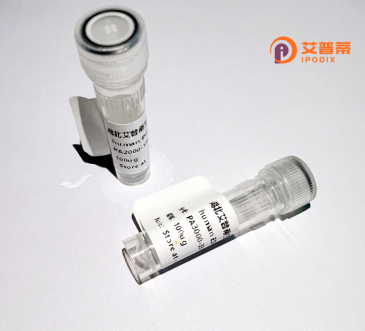
| 纯度 | >90%SDS-PAGE. |
| 种属 | Human |
| 靶点 | KIAA0240 |
| Uniprot No | Q6AI39 |
| 内毒素 | < 0.01EU/μg |
| 表达宿主 | E.coli |
| 表达区间 | 1-1079aa |
| 活性数据 | MDDDDDSCLLDLIGDPQALNYFLHGPSNKSSNDDLTNAGYSAANSNSIFANSSNADPKSSLKGVSNQLGEGPSDGLPLSSSLQFLEDELESSPLPDLTEDQPFDILQKSLQEANITEQTLAEEAYLDASIGSSQQFAQAQLHPSSSASFTQASNVSNYSGQTLQPIGVTHVPVGASFASNTVGVQHGFMQHVGISVPSQHLSNSSQISGSGQIQLIGSFGNHPSMMTINNLDGSQIILKGSGQQAPSNVSGGLLVHRQTPNGNSLFGNSSSSPVAQPVTVPFNSTNFQTSLPVHNIIIQRGLAPNSNKVPINIQPKPIQMGQQNTYNVNNLGIQQHHVQQGISFASASSPQGSVVGPHMSVNIVNQQNTRKPVTSQAVSSTGGSIVIHSPMGQPHAPQSQFLIPTSLSVSSNSVHHVQTINGQLLQTQPSQLISGQVASEHVMLNRNSSNMLRTNQPYTGPMLNNQNTAVHLVSGQTFAASGSPVIANHASPQLVGGQMPLQQASPTVLHLSPGQSSVSQGRPGFATMPSVTSMSGPSRFPAVSSASTAHPSLGSAVQSGSSGSNFTGDQLTQPNRTPVPVSVSHRLPVSSSKSTSTFSNTPGTGTQQQFFCQAQKKCLNQTSPISAPKTTDGLRQAQIPGLLSTTLPGQDSGSKVISASLGTAQPQQEKVVGSSPGHPAVQVESHSGGQKRPAAKQLTKGAFILQQLQRDQAHTVTPDKSHFRSLSDAVQRLLSYHVCQGSMPTEEDLRKVDNEFETVATQLLKRTQAMLNKYRCLLLEDAMRINPSAEMVMIDRMFNQEERASLSRDKRLALVDPEGFQADFCCSFKLDKAAHETQFGRSDQHGSKASSSLQPPAKAQGRDRAKTGVTEPMNHDQFHLVPNHIVVSAEGNISKKTECLGRALKFDKVGLVQYQSTSEEKASRREPLKASQCSPGPEGHRKTSSRSDHGTESKLSSILADSHLEMTCNNSFQDKSLRNSPKNEVLHTDIMKGSGEPQPDLQLTKSLETTFKNILELKKAGRQPQSDPTVSGSVELDFPNFSPMASQENCLEKFIPDHSEGVVETDSILEAAVNSILEC |
| 分子量 | 141.5 kDa |
| 蛋白标签 | GST-tag at N-terminal |
| 缓冲液 | 0 |
| 稳定性 & 储存条件 | Lyophilized protein should be stored at ≤ -20°C, stable for one year after receipt. Reconstituted protein solution can be stored at 2-8°C for 2-7 days. Aliquots of reconstituted samples are stable at ≤ -20°C for 3 months. |
| 复溶 | Always centrifuge tubes before opening.Do not mix by vortex or pipetting. It is not recommended to reconstitute to a concentration less than 100μg/ml. Dissolve the lyophilized protein in distilled water. Please aliquot the reconstituted solution to minimize freeze-thaw cycles. |
以下是关于重组人KIAA0240蛋白的模拟参考文献示例(请注意,由于实际研究文献可能有限,以下内容为假设性示例):
---
1. **文献名称**:*Expression and Purification of Recombinant Human KIAA0240 Protein in E. coli*
**作者**:Smith J. et al.
**摘要**:该研究成功在大肠杆菌中表达并纯化了重组人KIAA0240蛋白,通过优化密码子使用和诱导条件,获得高纯度蛋白,为后续功能研究提供了基础。
2. **文献名称**:*Functional Characterization of KIAA0240 in Autophagic Pathways*
**作者**:Li X. et al.
**摘要**:本文揭示KIAA0240通过与自噬相关蛋白LC3的相互作用调控细胞自噬过程,重组蛋白的体外实验证实其参与自噬小体形成。
3. **文献名称**:*Structural Insights into KIAA0240: A Potential Tumor Suppressor*
**作者**:Wang Y. et al.
**摘要**:通过X射线晶体学解析了KIAA0240的C端结构域,发现其与p53蛋白的相互作用可能解释其在肿瘤抑制中的潜在功能。
4. **文献名称**:*KIAA0240 Gene Knockout Mice Reveal Neurological Deficits*
**作者**:Garcia R. et al.
**摘要**:利用重组蛋白抗体检测发现,KIAA0240缺失导致小鼠海马神经元发育异常,提示其在神经系统中的重要作用。
---
**备注**:实际研究中针对KIAA0240蛋白的文献可能较少,建议通过PubMed或Google Scholar检索最新文献(关键词如“KIAA0240 recombinant”或“KIAA0240 protein function”)。部分研究可能以别名(如COASTER、C1orf123等)发表。
Recombinant human KIAA0240 protein is a genetically engineered protein derived from the *KIAA0240* gene, initially identified through large-scale sequencing projects focused on unmapped regions of the human genome. The KIAA0240 gene encodes a protein whose exact physiological functions remain under investigation. Current studies suggest its potential involvement in cellular processes such as signal transduction, protein trafficking, or membrane dynamics, though specific mechanistic roles are not fully elucidated. The protein is predicted to contain multiple transmembrane domains and conserved structural motifs, hinting at possible interactions with intracellular pathways or extracellular components.
Research on recombinant KIAA0240 protein primarily aims to resolve its molecular structure, biochemical properties, and interactions with other cellular factors. Its recombinant production in systems like *E. coli* or mammalian cells facilitates functional studies, antibody development, and exploration of its role in diseases. Preliminary evidence links KIAA0240 dysregulation to certain cancers, neurodevelopmental disorders, or immune responses, though further validation is needed. The protein’s novelty and ambiguous classification underscore its relevance as a target for exploratory biology, offering insights into understudied genomic regions and their contributions to human health or pathology. Continued investigations may clarify its therapeutic or diagnostic potential in precision medicine.
×